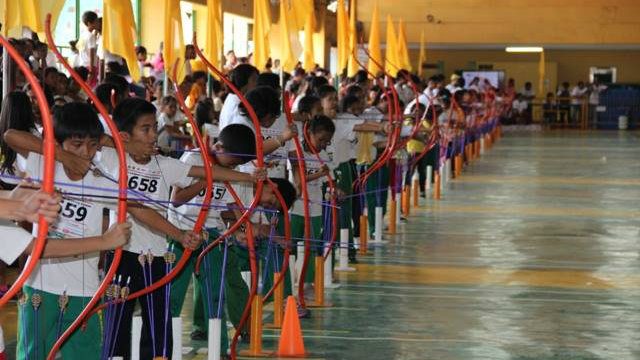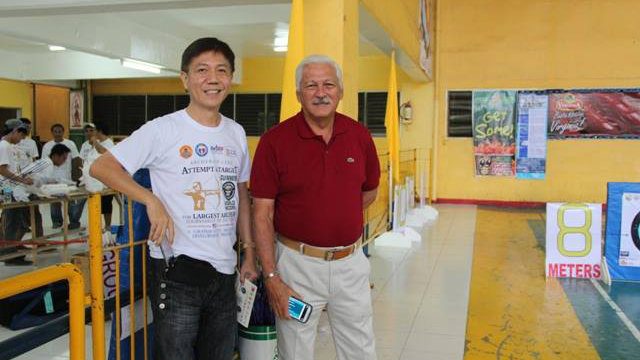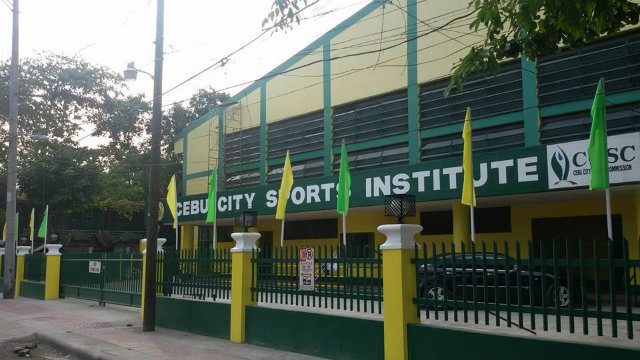SUMMARY
This is AI generated summarization, which may have errors. For context, always refer to the full article.

CEBU CITY, Philippines – Volunteerism and linkages with the Department of Education and the barangays are the keys to Cebu City’s successful implementation of its grassroots development program in sports, according to Edward Hayco, the chairman of the Cebu City Sports Commission (CCSC).
The program have been able to train thousands of kids in various sports at a very minimal expense.
Just recently, the Philippine Sports Commission (PSC) through its chairman, Ricardo “Richie” Garcia, expressed the intention of making Cebu City’s grassroots program the template to be followed by everyone else in the country who wants to put up the same development in sports.
With this, Hayco has been tasked to make a presentation during a conference and seminar organized by PSC on March 17.
The city’s grassroots currently has two programs – the Bakbakan sa Sugbu Grassroots Sports Development Program and the Summer Grassroots Program for dancesports, basketball, volleyball, baseball, softball, soccer/football, table tennis, arnis, karatedo, Muay Thai, MMA, boxing, badminton, archery, chess, weightlifting, sepak takraw and the newest ones – swimming and running both marathon and track and field. Participants do not have to pay anything to learn and train under the program.
Hayco was appointed as chairman of the CCSC in 2010 because of the success of the Dancesports grassroots program, which he, as the director of the Dancesports Tean Cebu City (DTCC), and his wife, Eleonor, and a couple of volunteers started in 2000.
“They (the city) wanted me to duplicate what we did in dancesports, which we faithfully did,” Hayco said.
Hayco got the idea of doing a grassroots program for dancesports from former Cebu City mayor Tomas Osmena. The DTCC had made a courtesy call to Osmena to present to him the gold medals that they were able to clinch from a national competition and Osmena, in his usual blunt way, told them he has no need of their medals but that the only way to make it count is to give it back to the community, and thus the dancesports grassroots was born.
Among DTCC grassroots’ achievement were raking in over 2,000 medals in international and national competitions; winning the first medal, a gold at that, for the Philippine delegation to the International Children’s Games; clinching the first gold medal for dancesports in the 2005 Southeast Asian Games; producing the first World Youth champions in Jessa Briones and Samson Orlanes in the Nevada Starball Championship in Las Vegas in August 2011; and turning a scavenger from Tejero, Wilbert Aunzo, into a nine-time national champion and with his partner, Pearl Marie Caneda, became the champions in the 68th edition of the Australian Dancesport Championship in Melbourne Australia in 2013.
During that championship in Las Vegas, Briones was approached by the angry American coach of the American youth team who she and Orlanes beat and was told “My athletes trained in Germany, Slovenia, Russia and England. You, where were you trained?,” to which the innocent Briones replied “in Bulacao Pardo.”

Bulacao Pardo is one of the 80 barangays of Cebu City wherein DTCC held one of its grassroots program, inviting the kids from impoverished families who reside in the area.
“Her (Briones) answer is very meaningful to all of the volunteers who have served the team because Jessa comes from an impoverished area in Cebu,” said Hayco.
The dancesports grassroots was started with DTCC coordinating with the DepEd and the barangays via the former Sangguniang Kabataan in gathering kids in the barangay or school gyms and training them. The coaches and trainers were members of the DTCC. It didn’t matter if they were already gold medalists, the policy was they have to hand down what they have learned to the kids via the grassroots program, sort of paying it forward. Those who showed potential, such as Briones and Aunzo, were further trained. Now on its 15th year, the program has already trained about 30,000 kids.
Their catchphrase “transforming our youth through dance,” Hayco said basically explains “what we believed in, what we want to do and it also describes our advocacy.” He added that it has been very fullfilling and meaningful for all of the volunteers that they were able to offer their time and provide free lessons to the kids from the impoverished areas not only in Cebu City but also in some towns of the Cebu Province, and many parts in Visayas and Mindanao.
Despite the success of the dancesports grassroots program, doing the same for the other sports under the Cebu City grassroots program was daunting for Hayco.
“It was so challenging because you’re working with people you have never worked with before. Basically, I’m not a sportsman and neither am I an athlete. I was in LA during the 1984 Olympics, I could see the flame from my hotel room, I didn’t even go and watch. It was the same during the Sydney Olympics. It was daunting for me. I was like the round peg in a square hole, and I felt so off. But my strength is my business background, the other experiences I have in life, that, or my being an outsider looking in, which gives a fresh new look on how to go about things.”
Asked if he ever doubted he would be successful faced with the daunting task, Hayco said “that doubt came in more than I can count.” He said that teaching dancesports may not be easy but it is just one sport, the grassroots program entailed more than just one sport.
It did not help that he decided to start with the sport of boxing but Hayco explained that he chose the sport because when he got into the commission, Dodie Boy Penalosa, a former IBF champion in the junior flyweight and flyweight classes, and Efren Tabanas, an Olympian boxer, were already there and training a few kids.
“I am reactive, whatever falls into my lap, I work on,” Hayco said.
Plus, the training took place at the abandoned and dilapidated San Nicolas Sports Complex, which needed a lot of work. They had to clean out the place not only of garbage that accumulated over the years but they also had to drive out the squatters who made the complex their residence. Because the complex was surrounded by seven notorious barangays, Hayco said it made sense to promote first contact sports.
Aside from boxing, they introduced taekwondo and arnis to the kids coming from the surrounding barangays. Next, they brought in other sports such as table tennis and chess.
Two years later, they had to renovate the San Nicolas Sports Complex, so Hayco said they went back to what they know best, which is linking up with Deped and the barangays in gathering kids in their respective barangays and training them.
Despite the formula proven to be very effective already, Hayco admitted that for the first three years, it was very chaotic and disorganized and that they produced nothing but rotten eggs. But, they were able to experiment and finally hit on the formula that works.
“It is one thing to gather kids and teach them dancesports, but to gather and teach them several sports has been very challenging. How will you communicate to 80 public schools, various sports with different schedule in 16 different locations, so it was so chaotic, gubot (messy) for the last three years, and on the third year we were telling ourselves, if we don’t make it this year, we will give up,” Hayco said.
The solution came in what Hayco calls the “grocery sports”. It entails gathering the kids in one place wherein all the sports are taught. The plan is better because the kids will get to choose what sports they want. This they did in 17 public school gyms since last year and the program has been able to train 5,000 new kids so far in the summer.
Hayco said he is more of a spiritual person rather than a religious person and he believes that there has been a divine intervention in what they have been doing. “Everything just falls into place at the right time. We pushed things so hard, they don’t happen.” In explaining this, Hayco cited as an example their newest grassroots in swimming. He said the concept of training swimmers was formed about three years ago but all just fell into place last month and they were able to start training the Badjao kids. This concept is in line with their new plan of identifying athletes in their natural environment.
Although Hayco now believes they have the right formula for the grassroots program, the CCSC will not stop in trying out new ideas to further develop Cebu sports. Aside from teaching the Badjao kids the right technique in swimming, the CCSC will also be teaching marathon and athletics to the kids in the mountain barangays following the Kenyan concept.
Hayco had asked the many Kenyans who dominate the run competitions in Cebu how they train. He was told that because most of them live in the mountains, they train in the higher altitude and get used to the thin air, thus when they race in the lower area, they go faster.
Another new idea for the program is instead of training kids in beach volleyball, they will gather all coaches here in Cebu and have them train coaches in public schools then they in turn will be the one to impart the sport to the kids in their respective schools.
CCSC’s policy remains, it will send the kids to national sporting competitions such as Batang Pinoy and the Philippine National Youth Games but in return the coaches and the kids themselves must be willing to volunteer for the grassroots program.
An Australian dancesports champion have once told Hayco that the Philippines is not a rich country and thus cannot afford to hire world-class coaches but what the CCSC is doing now is the only way that the country can win an Olympic medal.
“He told me that our advocacy is the only way we can win a gold medal and proof enough is Aunzo. He did not spend a single centavo for a good coaching, but did he win a world championship, yes,” Hayco said.
Last year, renovations to the San Nicolas Sports Complex were done and the place has been reopened as the Cebu City Sports Institute. Contact sports training have resumed and now have a monthly sportsfest called “Bakbakan” held every last Saturday of the month.

Asked how he succeeded in forging partnerships with institutions such as the DepEd and the barangays when so many others failed, Hayco says “one key to get the willingness of people to work for you is to let them know your purpose, sell them the idea and make them believe in your purpose.”
And, no entitlements. Hayco has always been candid in admitting that he is not a sportsman and that all activities under the program have not been his idea alone but from his staff, commissioners, teachers and other people. He listened, accepted these ideas and together they worked on it.
The city’s grassroots program was also able to emulate the Guinness World Record achieved by DTCC—the largest dance class with 7,770 participants in 2009. Through the grassroots program, CCSC was able to post a record for the biggest chess tournament with 43,157 participants in 2012. Another Guinness World Record of largest archery lesson and tournament was attempted last year which successfully broke the record held by the USA of 9,426 with 13,102 participants.
Guinness has yet to confirm the record, however.
The Bakbakan so far has produced two notable athletes in 15-year-old Evangelito Dale Ceniza of Pasil Elementary Night School and Leonida Cambarijan who both posted new records in the snatch event of weighlifting in the Batang Pinoy Nationals.
Hayco is more than willing to share the template that the CCSC used for its grassroots program. “I don’t care if they don’t credit Cebu City, I just want to share the template to all LGUs,” said Hayco who added that they have been getting emails and calls from other LGUs asking for their help.
According to Hayco, there are already more than five LGUs who are working on using the Cebu City Grassroots Development Program as a model for their own grassroots development.
His advice to those just starting out: “Everything at the right time will fall into place but you also have to keep working on it, just continue hitting your head on the wall until you find an opening.”
With things finally in place, Hayco said they will now work on institutionalizing the grassroots program and making it into a movement. In doing this, he draws strength from three old woman, strangers, who have approached him and told him how much they appreciated the program and that by doing it they have created a movement.
“We will institutionalize it and create it into a movement so that even if we’re no longer around, the culture that we have created will move the sports community in one direction,” said Hayco adding that at present, they have already created a culture of helping each other and no entitlement.
On how to do this, Hayco said that “first they create the structure then the culture because it is the culture that will sustain the structure, if not it will just crumble. Once you have a strong foundation of the structure because of the culture, you can move on to making it a movement so it will have a life of its own.”
Hayco is leading this initiative because he sees it as a commitment that he made. For him, it is a job.
– Rappler.com
Add a comment
How does this make you feel?
There are no comments yet. Add your comment to start the conversation.